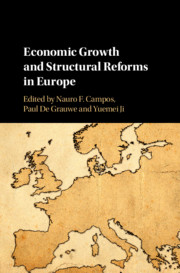Book contents
- Economic Growth and Structural Reforms in Europe
- Economic Growth and Structural Reforms in Europe
- Copyright page
- Contents
- Figures
- Tables
- Contributors
- Introduction
- Part I Economic Growth and Structural Reforms in Europe
- Part II Macroeconomic Implications of Reforms
- Part III Case Studies
- 10 Structural Reforms in Europe
- 11 Fiscal Consolidation and Inequality
- 12 How Openness to Trade Rescued the Irish Economy
- 13 Goulash Labour Market Structural Reforms
- Conclusions
- Index
- References
11 - Fiscal Consolidation and Inequality
The Distributive Effects of Fiscal Reforms in Greece and Portugal
from Part III - Case Studies
Published online by Cambridge University Press: 31 March 2020
- Economic Growth and Structural Reforms in Europe
- Economic Growth and Structural Reforms in Europe
- Copyright page
- Contents
- Figures
- Tables
- Contributors
- Introduction
- Part I Economic Growth and Structural Reforms in Europe
- Part II Macroeconomic Implications of Reforms
- Part III Case Studies
- 10 Structural Reforms in Europe
- 11 Fiscal Consolidation and Inequality
- 12 How Openness to Trade Rescued the Irish Economy
- 13 Goulash Labour Market Structural Reforms
- Conclusions
- Index
- References
Summary
Following the inception of the economic adjustment programmes in the Eurozone, the EU has received much criticism for their handling of the social dimension of the crisis through their involvement in the Troika of European Commission, European Central Bank, and International Monetary Fund. One manifestation of this neglect of the social dimension can be found in the levels of economic inequality, particularly income inequality, in the countries that were part of the Troika programmes. Whilst the literature so far suggests that phases of fiscal consolidation correlate with increases in inequality levels, this chapter finds that this was not the case in the programme countries. The chapter undertakes a comparative case study between the Greek and Portuguese programmes in order to analyse the different effects of an expenditure-based programme with a revenue-based programme. It finds that relative inequality of disposable household incomes has stagnated rather than increased in most years throughout both programmes, with only minor upward fluctuations. In addition, a comparison with data on market income inequality in the same period shows that the redistributive efforts of the two countries have in fact increased, alleviating some of the recession-induced increases in market income inequality. Furthermore, simulating the distributive effects of a baseline scenario with unchanged tax-benefit policies from the year prior to the programme inception to its conclusion shows that in both cases, the reforms compressed the income distribution relative to the baseline scenario. In assessing the distributive effects of the fiscal consolidation measures, this chapter combines the use of real data (EU-SILC) and simulated data (based on tax-benefit microsimulation tool EUROMOD). Additionally, the chapter analyses the exact composition and compliance with the programmes. The combination of these approaches allows the conclusions that (1) the fiscal consolidation measures in the economic adjustment programmes had an inequality-reducing effect, which at times was sufficiently large to offset the inequality-increasing effects of the recessions in the programme countries, and that (2) this effect was larger when the Troika curtailed the discretion left to national governments in the development of suitable policy measures, and followed an approach of micro-management and close monitoring.
- Type
- Chapter
- Information
- Economic Growth and Structural Reforms in Europe , pp. 342 - 376Publisher: Cambridge University PressPrint publication year: 2020
References
- 1
- Cited by



